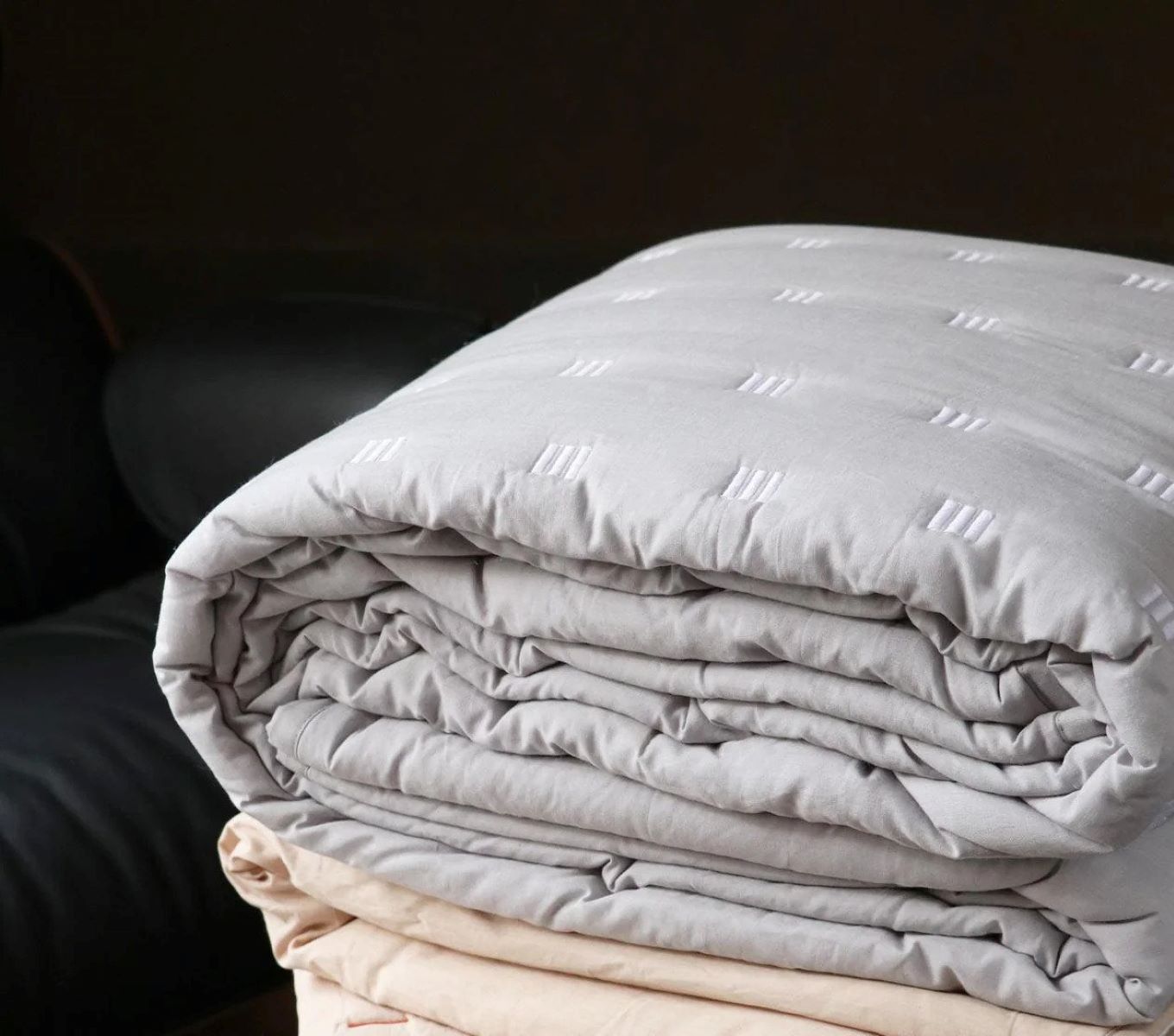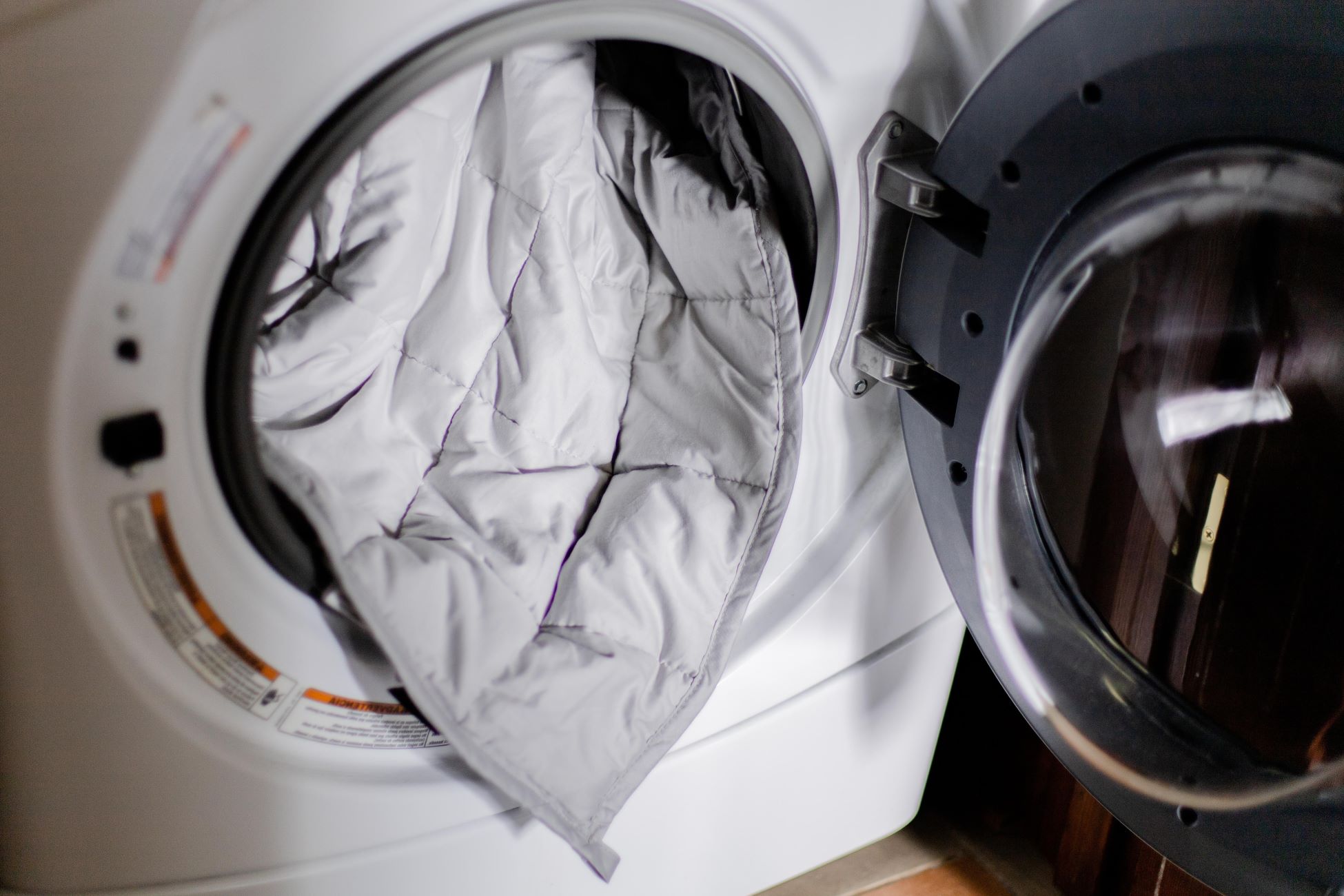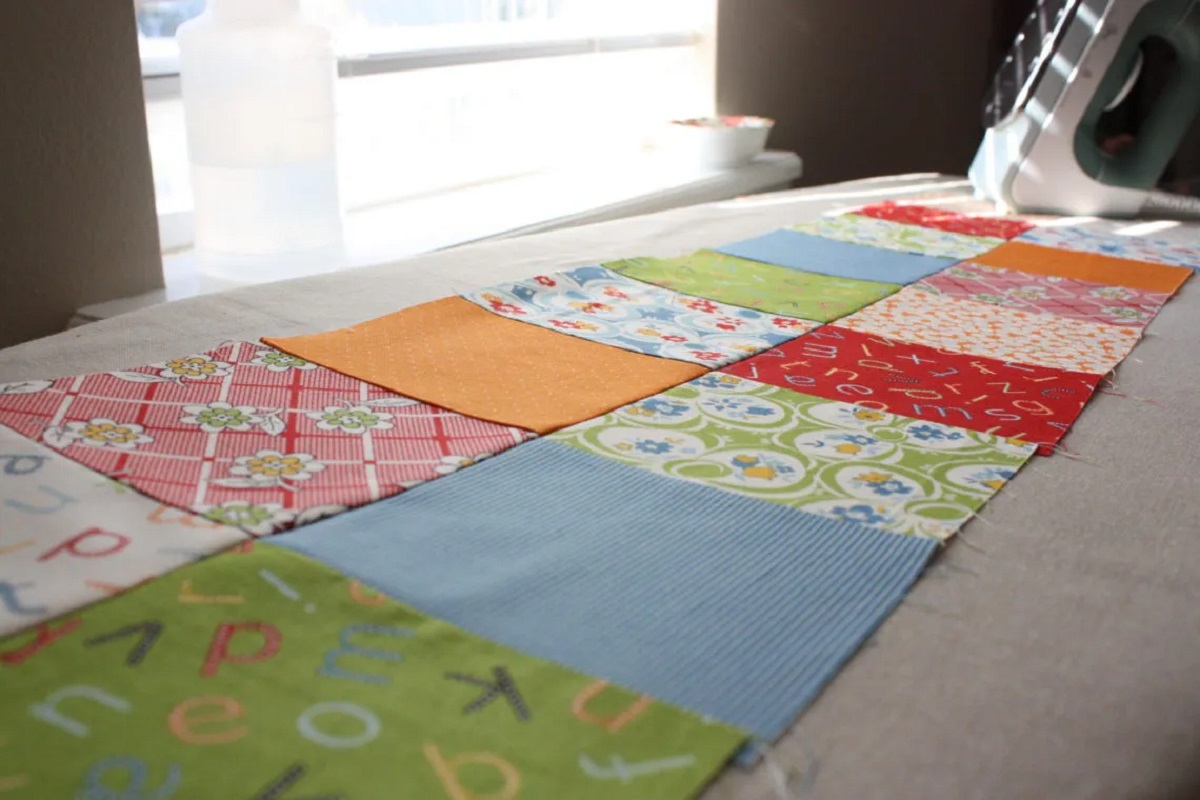

Articles
How To Wash A Quilt Blanket
Modified: October 19, 2024
Learn the proper technique for washing a quilt blanket with our comprehensive articles. Follow our step-by-step guide and keep your quilt clean and fresh.
(Many of the links in this article redirect to a specific reviewed product. Your purchase of these products through affiliate links helps to generate commission for Storables.com, at no extra cost. Learn more)
Introduction
Quilt blankets are not just functional items that keep us warm and cozy; they also represent artistry, craftsmanship, and sentimental value. Whether you have inherited a cherished family heirloom quilt or bought a handmade masterpiece, proper care and maintenance are essential to preserve its beauty and extend its lifespan.
In this article, we will guide you through the step-by-step process of washing a quilt blanket to ensure that it stays clean, fresh, and intact. We will cover both hand washing and machine washing methods, as well as provide insights on how to properly dry and store your quilt blanket.
Before we dive into the washing process, let’s gather the materials you will need:
- Mild detergent
- Bathtub or large basin
- Soft-bristle brush
- White vinegar
- Lint roller
- Large towel
- Plastic sheet or tarp
- Washing machine (if using the machine washing method)
Now that you have your materials ready, let’s move on to preparing the quilt blanket for cleaning.
Key Takeaways:
- Preserve the beauty and longevity of your quilt blanket by following gentle hand washing or machine washing methods, proper drying techniques, and thoughtful storage practices.
- Prioritize the unique care needs of your quilt blanket to maintain its sentimental value and artistry, ensuring it remains a cherished heirloom for generations to come.
Read more: How To Store Quilts And Blankets
Materials Needed
Before you begin washing your quilt blanket, it is important to gather all the necessary materials to ensure a successful and effective cleaning process. Here is a list of the materials you will need:
- Mild detergent: Choose a detergent that is gentle on fabrics and does not contain harsh chemicals or bleach. Look for detergents specifically formulated for delicate or hand washing.
- Bathtub or large basin: This will be used for hand washing your quilt blanket. Make sure it is clean and free of any dirt or residue.
- Soft-bristle brush: A soft-bristle brush is helpful for gently scrubbing away any stubborn stains or dirt spots on the quilt blanket. Avoid using brushes with stiff bristles that can damage the fabric.
- White vinegar: Vinegar is a natural and effective ingredient for removing odors and softening the fabric. It can be used as a fabric conditioner during the wash or as a spot treatment for stains.
- Lint roller: A lint roller is handy for removing any loose lint or pet hair from the quilt blanket before washing. This will help prevent the lint from clogging the washing machine or transferring onto other items.
- Large towel: A large towel is useful for drying the quilt blanket after washing. Choose a clean, absorbent towel that is big enough to wrap around the quilt blanket.
- Plastic sheet or tarp: If you are hand washing the quilt blanket on a flat surface, such as the floor or a table, protect the area with a plastic sheet or tarp to prevent any water damage.
- Washing machine (if using the machine washing method): If your quilt blanket is safe to machine wash, you will need access to a washing machine with a gentle or delicate cycle option. Make sure the machine is clean and free of detergent residue.
Having all these materials on hand will ensure that you have everything you need to properly clean your quilt blanket and achieve the best results without causing any damage to the fabric or design.
Preparing the Quilt Blanket
Before you begin washing your quilt blanket, it is important to properly prepare it to ensure a thorough and effective cleaning process. Here are the steps to follow:
- Inspect the quilt blanket: Check the quilt blanket for any visible stains, tears, or loose threads. Take note of any areas that require special attention during the cleaning process.
- Spot treat stains: If you notice any stains on the quilt blanket, apply a small amount of mild detergent or a mixture of water and vinegar directly to the stained area. Gently blot the stain with a clean cloth or sponge. Avoid rubbing vigorously, as this can cause the stain to spread or damage the fabric.
- Remove loose dirt and debris: Use a lint roller or vacuum cleaner with a soft brush attachment to gently remove any loose dirt, lint, or pet hair from the quilt blanket. This step will help prevent the dirt from spreading or clogging the washing machine.
- Secure loose threads: If you see any loose threads on the quilt blanket, use a needle and thread to carefully secure them. This will prevent the threads from unraveling or causing further damage during the washing process.
- Check fabric care instructions: Refer to the fabric care instructions provided by the manufacturer to determine if the quilt blanket is safe to wash. Some delicate or antique quilts may require professional cleaning or alternative cleaning methods.
- Take photographs: If you have a valuable or sentimental quilt blanket, it is a good idea to take photographs before washing. These photos will serve as documentation in case any damage occurs during the cleaning process.
By following these steps, you will ensure that your quilt blanket is properly prepared for the washing process. This will help prevent any further damage and allow for a successful and thorough clean.
Hand Washing Method
The hand washing method is often preferred for delicate or antique quilt blankets that may be too fragile for machine washing. Follow these steps to hand wash your quilt blanket:
- Fill the bathtub or large basin with lukewarm water: Fill the tub or basin with enough lukewarm water to fully immerse the quilt blanket. Avoid using hot water, as it can cause shrinking or damage to the fabric.
- Add mild detergent: Add a small amount of mild detergent to the water and gently swirl it around to create a soapy solution. Be sure to use a detergent that is suitable for delicate fabrics.
- Submerge the quilt blanket: Carefully place the quilt blanket into the soapy water, ensuring that it is fully submerged. Gently press and squeeze the quilt blanket to allow the soapy water to penetrate the fabric.
- Gently agitate and clean: Using a soft-bristle brush, gently agitate the quilt blanket to remove any stains or dirt spots. Focus on the areas that require extra attention. Avoid aggressive scrubbing, as it can damage the fabric and stitching.
- Drain the soapy water: Once the quilt blanket is clean, drain the soapy water from the tub or basin. Gently press the quilt blanket against the sides of the tub or basin to remove excess water.
- Rinse with clean water: Fill the tub or basin again with clean lukewarm water and submerge the quilt blanket. Gently agitate the quilt blanket to rinse away any remaining detergent residue.
- Use white vinegar as a fabric conditioner (optional): If desired, add a cup of white vinegar to the rinse water. White vinegar helps remove soap residue, softens the fabric, and eliminates odors.
- Repeat rinsing if necessary: If the water appears soapy or dirty after rinsing, drain the water and repeat the rinsing process until the water runs clear.
- Remove excess water: Carefully lift the quilt blanket from the tub or basin, supporting its weight to prevent stretching or tearing. Gently press the quilt blanket against the sides of the tub or basin to remove excess water.
- Dry the quilt blanket: Lay a large towel on a flat surface and place the damp quilt blanket on top. Roll the towel and quilt blanket together, gently pressing to absorb excess moisture. Unroll the towel and transfer the quilt blanket to another clean, dry towel, allowing it to air dry completely.
Using the hand washing method ensures that your quilt blanket receives gentle care while effectively cleaning it. It is important to handle the quilt blanket with care throughout the process to avoid damage to the delicate fabric or stitching.
When washing a quilt blanket, use a gentle cycle with mild detergent and cold water to prevent damage to the fabric and colors. Air dry or use a low heat setting in the dryer to avoid shrinking.
Machine Washing Method
If your quilt blanket is safe for machine washing, you can use the following steps to clean it:
- Check the quilt blanket for machine-wash instructions: Review the fabric care instructions on the quilt blanket or consult the manufacturer’s guidelines to ensure it is safe for machine washing. If the blanket is labeled as machine washable, proceed to the next steps.
- Pre-treat stains (optional): If there are any visible stains on the quilt blanket, pre-treat them with a small amount of mild detergent or stain remover. Follow the product instructions and allow it to sit on the stain for the recommended duration.
- Load the quilt blanket and select a gentle cycle: Place the quilt blanket in the washing machine, ensuring that it has enough space to move freely. Select a gentle or delicate cycle to minimize agitation and prevent damage to the quilt blanket.
- Add a mild detergent: Measure the appropriate amount of mild detergent for a medium-sized load, following the instructions on the detergent packaging. Avoid using too much detergent, as this can leave residue on the quilt blanket.
- Choose a cold water temperature: Select a cold water temperature for the wash cycle. Hot water can cause shrinking or damage to the fabric, so it is best to use cold water to protect the quilt blanket.
- Start the machine: Begin the machine wash cycle and allow it to run according to the recommended time for a delicate or gentle cycle.
- Extra rinse (optional): Once the wash cycle is complete, you can add an extra rinse cycle to ensure that all detergent residue is removed from the quilt blanket. This step is particularly important if you have a sensitive skin or if the quilt blanket is prone to detergent buildup.
- Remove the quilt blanket from the machine: Carefully remove the washed quilt blanket from the machine to minimize any twisting or stretching. Gently support the quilt blanket to prevent it from dragging on the floor.
- Dry the quilt blanket: Depending on the fabric and batting material, you may choose to air dry or tumble dry the quilt blanket. If air drying, lay it flat on a clean, dry surface, flipping it occasionally until it is completely dry. If tumble drying, use a low heat setting and add dryer balls or clean tennis balls to help fluff the quilt blanket and prevent clumping.
Remember to always follow the manufacturer’s instructions and guidelines specific to your quilt blanket. If you are unsure about machine washing, it is recommended to opt for the hand washing method to ensure the quilt blanket’s longevity and preservation.
Read more: How To Sew Satin Blanket Binding On A Quilt
Drying the Quilt Blanket
Properly drying your quilt blanket is crucial to prevent damage and ensure its longevity. Here are the recommended steps for drying your quilt blanket:
- Check the fabric care instructions: Refer to the fabric care instructions provided by the manufacturer to determine the recommended drying method for your specific quilt blanket. Some quilts may be suitable for air drying, while others can be tumble dried on low heat.
- Air drying method:
- Find a flat, clean surface: Choose a clean, dry surface where you can lay the quilt blanket to air dry. It could be a spare bed, clean floor, or large table.
- Spread out the quilt blanket: Gently spread out the quilt blanket on the chosen surface, smoothing out any wrinkles or folds.
- Flip and rotate: Periodically flip and rotate the quilt blanket during the drying process to ensure even drying and to prevent any creases from forming.
- Avoid direct sunlight: Place the quilt blanket away from direct sunlight, as prolonged exposure to the sun can fade the colors and weaken the fabric.
- Patience is key: Allow the quilt blanket to air dry naturally, which may take several hours or even a few days, depending on the thickness of the quilt and the humidity level in the environment.
- Tumble drying method:
- Prepare the dryer: If your quilt blanket is safe for tumble drying, place it in a clean dryer. Add a couple of clean tennis balls or dryer balls to help fluff the quilt blanket and prevent clumping.
- Select a low heat setting: Choose a low heat or delicate setting on your dryer to avoid overheating and potential damage to the quilt blanket.
- Dry in short intervals: Dry the quilt blanket in short intervals, checking frequently to ensure it does not overheat or shrink. Remove it when it is slightly damp to prevent over-drying.
- Fluff and fold: Once the quilt blanket is slightly damp, remove it from the dryer and give it a gentle shake to fluff up the fibers. Fold it neatly to prevent excessive wrinkling.
Remember, some delicate or antique quilt blankets may require exclusive air drying or professional handling to ensure their preservation. It is important to follow the specific recommendations provided by the manufacturer or seek professional advice if needed.
Storing the Quilt Blanket
Proper storage of your quilt blanket is essential to protect it from damage and preserve its quality over time. Follow these steps to store your quilt blanket correctly:
- Clean the quilt blanket: Before storing, ensure that your quilt blanket is clean and completely dry. Any dirt, stains, or moisture left on the quilt can lead to fabric discoloration, mold, or mildew during storage.
- Use acid-free tissue paper: To protect delicate fabrics and prevent creasing, place acid-free tissue paper between folded layers of the quilt blanket. This will help maintain the quilt’s shape and minimize friction between the fabric.
- Avoid plastic bags: Avoid storing your quilt blanket in plastic bags or airtight containers, as these can trap moisture and cause mildew or mold growth. Instead, opt for breathable storage options, such as cotton or linen bags, which allow air circulation.
- Choose a cool, dry location: Select a storage area that is cool, dry, and free from extreme temperatures and humidity. Basements, attics, and storage units prone to temperature fluctuations and dampness should be avoided.
- Provide protection from light: Exposure to direct sunlight can fade the colors of your quilt blanket over time. Store it in a place where it is shielded from natural or artificial light sources. If necessary, cover the quilt blanket with a light-blocking cloth or keep it in a darker area.
- Avoid hanging: Quilt blankets are best stored folded rather than hung. Hanging can stretch, distort, or put unnecessary strain on the fabric and stitching. It is advisable to fold the quilt and place it flat in the storage container.
- Check periodically: Regularly check on your stored quilt blanket to ensure it remains in good condition. Inspect for any signs of pests, moisture, or damage. If you notice anything unusual, take immediate action to address the issue and prevent further damage.
By following these storage guidelines, you can maintain the quality and longevity of your quilt blanket, preserving its beauty and sentimental value for years to come.
Conclusion
Taking proper care of your quilt blanket is essential to preserve its beauty, craftsmanship, and sentimental value. Whether you choose to hand wash or machine wash your quilt, it’s important to follow the recommended steps and use gentle cleaning methods to avoid damaging the fabric or stitching.
By prepping the quilt blanket, spot treating stains, and using appropriate materials, you can ensure a thorough and effective cleaning process. Remember to check the fabric care instructions and consult professionals if you are unsure about the best approach for your specific quilt blanket.
Drying the quilt blanket correctly is crucial to prevent damage. Whether you opt for air drying or tumble drying, follow the recommended steps and avoid exposing the quilt blanket to direct sunlight or excessive heat.
Storing your quilt blanket in a clean, dry, and breathable environment will help protect it from moisture, pests, and light damage. Use acid-free tissue paper to prevent creases and avoid plastic bags or airtight containers that can trap moisture.
By following these guidelines, you can maintain your quilt blanket’s quality and extend its lifespan. Regular inspection and care will ensure that your quilt remains a cherished item for generations to come.
Remember, each quilt blanket is unique, and it’s important to prioritize its specific care needs. If you have questions or concerns about cleaning or maintaining your quilt blanket, don’t hesitate to seek advice from professionals or reach out to quilt preservation experts.
With proper care, your quilt blanket will continue to bring warmth, comfort, and beauty into your life, preserving its rich history and craftsmanship for future generations to appreciate.
Frequently Asked Questions about How To Wash A Quilt Blanket
Was this page helpful?
At Storables.com, we guarantee accurate and reliable information. Our content, validated by Expert Board Contributors, is crafted following stringent Editorial Policies. We're committed to providing you with well-researched, expert-backed insights for all your informational needs.














